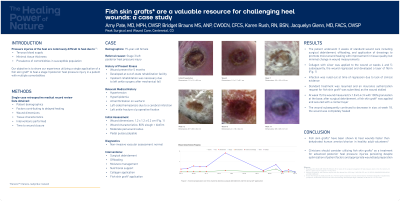Case Series/Study
(CS-109) Fish skin grafts* are a valuable resource for challenging heel wounds: a case study

Pressure injuries of the heel are notoriously difficult to heal due to tenuous blood supply, minimal tissue thickness, and prevalence of comorbidities among patients prone to these wounds.1,2 Our objective is to share our experience utilizing a single application of a fish skin graft* to heal a stage 3 posterior heel pressure injury in a patient with multiple comorbidities.
Methods:
We performed a retrospective medical record review to obtain information regarding patient demographics, factors contributing to delayed healing, wound measurements and characteristics, and interventions performed.
Results:
A 75-year-old female was referred for evaluation of a stage 3 left posterior heel pressure injury. History was significant for hypertension; hyperlipidemia; atrial fibrillation on warfarin; left-sided hemiparesis due to a cerebral infarction; and a semi-recent left ankle fracture due to a fall, requiring operative fixation and inpatient postoperative rehabilitation. The wound developed during her stay at an out-of-state rehabilitation facility, and had been present for five months. Initially, the wound measured 1.2 x1.2 x 0.2 cm. There was moderate periwound callus, and the wound bed was covered with biofilm and 80% slough. Pedal pulses were palpable. The patient underwent three weeks of standard wound care including surgical debridement, offloading, and application of dressings to promote moist wound healing with improvement in tissue quality, but minimal change in wound measurements. Vascular studies were obtained, which were negative. Collagen with silver was applied to the wound at weeks four and five. Subsequently, the wound regressed and developed a layer of fibrin. Infection was ruled out. Standard treatment was resumed and an insurance authorization request for fish skin graft* was submitted, as the wound stalled. At week 15, the wound measured 2 x 1.8 x 0.4 cm with 100% granulation at the base. After surgical debridement, a fish skin graft* was applied and secured with a contact layer. The wound subsequently continued to decrease in size; at week 18, the wound was completely healed.
Discussion:
Fish skin grafts* are cost-effective and have been shown to heal wounds faster than dehydrated human amnion/chorion in healthy adult volunteers.3 Clinicians should consider utilizing fish skin grafts* as a treatment for advanced posterior heel pressure injuries persisting despite optimization of patient factors and appropriate wound bed preparation.
Trademarked Items: *KerecisTM, Kerecis, Isafjordur, Iceland
References: 1.Bosanquet DC, Wright AM, White RD, Williams IM. A review of the surgical management of heel pressure ulcers in the 21st century. Int Wound J. 2016;13(1):9-16. doi:10.1111/iwj.12416
2.Delmore B, Ayello EA. Heel Pressure Injuries. Adv Skin Wound Care. 2021 May 1;34(5):236-237. doi: 10.1097/01.ASW.0000742304.60363.e3. PMID: 33852459.
3.Kirsner RS, Margolis DJ, Baldursson BT, et al. Fish skin grafts compared to human amnion/chorion membrane allografts: A double-blind, prospective, randomized clinical trial of acute wound healing. Wound Repair Regen. 2020;28(1):75-80. doi:10.1111/wrr.12761

.png)